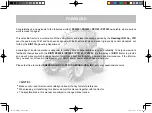
MAINTENANCE
06.16
Maintenance
11-04
RoGator 418
Jump Starting
If it is necessary to use an extra battery to start the
engine,
BE EXTREMELY CAREFUL
. This is a two
person operation. There must be one person in the
operator's seat and one person to connect and
disconnect the battery cables.
WARNING
!
When connecting an extra ba t-
tery for "jump" starting, make
the last connection (negative
cable) to the frame or engine
(never at the battery). When
removing the "jump" start ca-
bles, remove the negative cable
from the engine or frame first.
1. The key switch must be in the
OFF
position.
2. The battery to be used must be of the same
voltage as the one installed.
3. Battery terminals have identification marks.
The positive terminal is marked (+) and the
negative terminal is marked (-). The negative
terminal (-) of the battery must be connected to
the engine.
4. If the booster battery is in another vehicle, do
not operate the engine when making cable
connections or starting the RoGator. This will
prevent possible damage to the electrical
system.
WARNING
!
Be sure that the machines do
not contact each other.
NOTE: Remove the cover from the positive
terminal and from the negative terminal; re-
place the covers on the terminals after charg-
ing is completed.
5.
Connect the end of the first cable to the posi-
tive terminal (+) of the booster battery. Con-
nect the other end of the same cable to the
positive terminal (+) of the RoGator battery.
6.
Connect the end of the second cable to the
negative terminal (-) of the booster battery.
Connect the other end of the second cable to
the engine or frame.
DO NOT
connect the
cable directly to the negative terminal (-) of
the RoGator battery.
7.
Start the RoGator engine.
8.
After the engine has started, remove the ca-
ble connected to the RoGator engine or
frame. Then remove the cable from the Ro-
Gator battery positive terminal (+).
Storage of Vehicle
If the vehicle is in storage for several months, the
following procedures will help prevent excessive
deterioration.
1.
Replace the engine oil and filter. Operate the
engine until it is warm to allow the new oil to
circulate.
2.
Drain, flush and fill the engine cooling system.
Use a 50/50 solution of ethylene glycol
antifreeze and soft clean water. Do not use
stop leak additives.
3.
Drain the fuel tank. Add a small amount of fuel
and corrosion inhibitor.
4.
Disengage battery lever. Remove, clean,
charge and put the batteries in storage.
5.
Paint all damaged spots and apply primer on
all unpainted surfaces.
6.
Blow out all air lines.
7.
Make sure all components and systems are
cool.
8.
Clean the vehicle, removing all mud, dirt,
grease and other foreign material.
9.
To prevent rust, paint any damaged areas and
put corrosion inhibitor on unpainted metal
(hydraulic cylinders, rods, control linkages,
etc.).
10.
If possible, put the vehicle in a dry, inside
storage place. If it is necessary to put the
vehicle in storage outside, cover it with a water
resistant canvas or other acceptable material.
11.
Loosen the engine drive belts.
12.
Cover openings on the engine, transmission,
air cleaner intake, fuel tanks, electrical system
and hydraulic system with plastic bags and
tape.
13.
Block the vehicle up so the tyres are not on the
ground. Keep the tyres from heat, light and
water.
Before Operating after Long Storage
1. Check the tire air pressure and remove the
blocks from the vehicle.
2. Remove all protective covers from the vehicle.
3. Tighten the engine bolts.
4. Remove the batteries from storage. Install the
batteries in the vehicle and connect the
cables. Make sure the batteries have a full
charge. Engage the battery lever.
5. Check the oil in the engine, transmission,
hydraulic system and pressure washer pump.
Add oil as necessary. Check radiator coolant
level. Fill the fuel tanks.











































